豆科作物作为恢复煤矿农业生态系统复垦土壤功能的自然策略
IF 5
2区 农林科学
Q1 SOIL SCIENCE
引用次数: 0
摘要
长期种植豆科作物作为一种基于自然的策略(NbS)具有恢复煤矿农业生态系统复垦土壤功能的潜力。然而,豆科作物种植对复垦土壤理化性质和微生物群落结构的影响尚不清楚。为了解决这一问题,在某煤矿复垦农业区进行了长达十年的豆科作物原位试验。结果表明,与对照相比,大豆处理没有显著改变土壤田间水分容量。土壤容重、固液相比例显著降低,气相比例显著增加(p < 0.05),土壤三相结构距离显著减小(p < 0.05)。土壤有机质、全氮和无机氮含量显著降低,全磷、易氧化有机碳、速效磷和速效钾含量显著升高(p < 0.05)。关键菌门为变形菌门、酸性菌门和放线菌门,优势真菌门为子囊菌门、Mortierellomycota门和担子菌门。GLY处理下细菌和真菌的α多样性显著低于对照组,β多样性差异显著(p < 0.05)。此外,细菌群落网络的复杂性比真菌更为明显,大豆处理组的细菌关键种明显多于真菌。土壤容重、三相结构距离、全磷和全氮是土壤微生物群落的主要调节因子。这些研究结果表明,豆科作物在改善复垦土壤理化性质和优化微生物群落结构方面具有重要作用。总之,本研究强调了豆科作物在维持煤矿生态系统多功能复垦土壤中的关键作用,以及豆科作物在土壤复垦中的应用已经是一种长期的实践。本文章由计算机程序翻译,如有差异,请以英文原文为准。

Leguminous crops as a nature-based strategy to restore the functionality of reclaimed soils in coal mine agroecosystem
Long-term cultivation of leguminous crops as a nature-based strategy (NbS) has potential for restoring the functionality of reclaimed soils in coal mine agroecosystems. However, the impacts of leguminous crop planting on the physicochemical properties and microbial community structure of reclaimed soil remain poorly understood. To address this issue, a decade-long situ leguminous crop experiment was conducted in a coal mine reclamation agricultural area. The results revealed that, compared with the control, the soybean treatment did not significantly alter the soil field water capacity. However, the soil bulk density and the proportions of solid- and liquid-phases were significantly lower, whereas the gas-phase proportion increased significantly (p < 0.05), and significantly decreased the soil three-phase structure distance (p < 0.05). The soil organic matter, total nitrogen, and inorganic nitrogen contents decreased significantly, whereas the total phosphorus, easily oxidized organic carbon, available phosphorus, and available potassium contents increased significantly (p < 0.05). The key bacterial phyla included Proteobacteria, Acidobacteriota, and Actinobacteriota, while the dominant fungal phyla were Ascomycota, Mortierellomycota, and Basidiomycota. The alpha diversity of both bacteria and fungi under GLY treatment was significantly lower than that in the control, with notable differences in β diversity (p < 0.05). Furthermore, bacterial community network complexity was more pronounced than that of fungal, with the soybean treatment group harboring significantly more bacterial key species than fungal species. Soil bulk density, three-phase structure distance, total phosphorus, and total nitrogen are the primary regulators of soil microbial communities. These findings underscore the efficacy of leguminous crop planting as an NbS for enhancing soil physicochemical properties and optimizing microbial community structure of reclaimed soil. In conclusion, this study highlights the critical role of leguminous crops in sustaining multifunctional reclaimed soils in coal mine ecosystems and the use of leguminous crops for soil reclamation as already a long-established practice.
求助全文
通过发布文献求助,成功后即可免费获取论文全文。
去求助
来源期刊

Applied Soil Ecology
农林科学-土壤科学
CiteScore
9.70
自引率
4.20%
发文量
363
审稿时长
5.3 months
期刊介绍:
Applied Soil Ecology addresses the role of soil organisms and their interactions in relation to: sustainability and productivity, nutrient cycling and other soil processes, the maintenance of soil functions, the impact of human activities on soil ecosystems and bio(techno)logical control of soil-inhabiting pests, diseases and weeds.
 求助内容:
求助内容: 应助结果提醒方式:
应助结果提醒方式:


